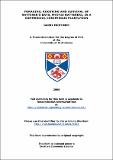Files in this item
Foraging, roosting and survival of Natterer’s bats, Myotis Nattereri, in a commercial coniferous plantation
Item metadata
| dc.contributor.advisor | Graves, Jeff | |
| dc.contributor.author | Mortimer, Garry | |
| dc.coverage.spatial | 198 | en_US |
| dc.date.accessioned | 2015-04-15T13:52:44Z | |
| dc.date.available | 2015-04-15T13:52:44Z | |
| dc.date.issued | 2006 | |
| dc.identifier | uk.bl.ethos.517421 | |
| dc.identifier.uri | https://hdl.handle.net/10023/6483 | |
| dc.description.abstract | I studied Natterer's bats in Tentsmuir Forest, a 9143-hectare commercial coniferous plantation on the NE coast of Fife, Scotland that has been planted predominantly with Scots and Corsican pine. Two maternity colonies of approximately 111 & 68 adult females regularly use bat boxes within the forest as summer and maternity roosts. The foraging ecology, roost dynamics, population structure and survival rates of the Natterer's bats present were determined in this study by radio tracking and banding. The two colonies occupied home ranges of 4.43 & 6.46 km2 with densities of approximately 25 & 10 adult females per km2 . Individual bats had a mean foraging home range of 0.47 km2 that contained 1-3 core foraging areas, which did not overlap with the core areas of other individual bats. Adult female Natterer's bats preferentially foraged in stands of mature Corsican pines and around water bodies; grazing meadows and arable land adjacent to the forest were avoided. They also foraged extensively in mature Scots pine, the predominant habitat. However, it was underused relative to its availability. Out of a set of five different bat box types, the bats preferentially chose old square wooden and round woodcrete boxes to use as summer and maternity roosts. I found that the bats also roosted in a specific type of natural cavity in double-Ieadered Corsican pines that has not been recorded before. Bats changed roost sites every 2.5 days on average. Natural tree roosts were used significantly more than bat boxes; however, there were no significant difference in the number of day's bats occupied the different roosts. Once a female was older than 1 year old the annual survival rate was between 0.79-0.87. Juveniles had a first year survival rate of 0.38-0.58. It was not possible to calculate male survival rates. These findings shed new light on how commercial plantations are a valuable foraging and roosting habitat for Natterer's bats and given the large amount of commercial coniferous forest now planted in the U.K. this has important implications for planning and implementing conservation management of these species. Chapter 7 contains an action plan with recommendations on how to improve existing and new coniferous forests to make them more "bat friendly" and to promote bat conservation. | en_US |
| dc.language.iso | en | en_US |
| dc.publisher | University of St Andrews | |
| dc.rights | Creative Commons Attribution-NonCommercial-NoDerivatives 4.0 International | |
| dc.rights.uri | http://creativecommons.org/licenses/by-nc-nd/4.0/ | |
| dc.subject.lcc | QL737.C595M7 | |
| dc.title | Foraging, roosting and survival of Natterer’s bats, Myotis Nattereri, in a commercial coniferous plantation | en_US |
| dc.type | Thesis | en_US |
| dc.type.qualificationlevel | Doctoral | en_US |
| dc.type.qualificationname | PhD Doctor of Philosophy | en_US |
| dc.publisher.institution | The University of St Andrews | en_US |
This item appears in the following Collection(s)
Except where otherwise noted within the work, this item's licence for re-use is described as Creative Commons Attribution-NonCommercial-NoDerivatives 4.0 International
Items in the St Andrews Research Repository are protected by copyright, with all rights reserved, unless otherwise indicated.


